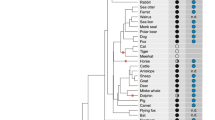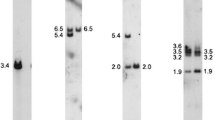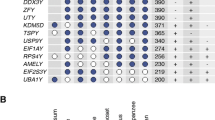Abstract
In eutherians, the sex-reversing ATRX gene on the X has no homologue on the Y chromosome. However, testis-specific and ubiquitously expressed X-borne genes have been identified in Australian marsupials. We studied nucleotide sequence and chromosomal location of ATRX homologues in two American marsupials, the opossums Didelphis virginiana and Monodelphis domestica. A PCR fragment of M. domestica ATRX was used to probe Southern blots and to screen male genomic libraries. Southern analysis demonstrated ATRX homologues on both X and Y in D. virginiana, and two clones were isolated which hybridized to a single position on the Y chromosome in male-derived cells but to multiple sites of the X in female cells. In M. domestica, there was a single clone that mapped to the X but not to the Y, suggesting that it represents the M. domestica ATRX. However a male-specific band was detected in Southern blots probed with the D. virginiana ATRY and with a mouse ATRX clone, which implies that the Y copy in M. domestica has diverged further from other ATRX homologues. Thus there appears to be a Y-borne copy of ATRY in American, as well as Australian marsupials, although it has diverged in sequence, as have other Y genes that are testis-specific in both eutherian and marsupial lineages.
Similar content being viewed by others
References
Amrine-Madsen H, Scally M, Westerman M, Stanhope MJ, Krajewsky C, Springer M (2003) Nuclear gene sequences provide evidence for the monophyly of australidelphian marsupials. Mol Phylogenet Evol 28: 186–196.
Charleswort B (1991) The evolution of sex chromosomes. Science 251: 1030–1033.
Church GM, Gilbert W (1984) Genomic sequencing. Proc Natl Acad Sci USA 81: 1991–1995.
Corpet F (1988) Multiple sequence alignment with hierarchical clustering. Nucl Acids Res 16: 10881–10890.
Delbridge ML, Harry JL, Toder R et al. (1997) A human candidate spermatogenesis gene, RBM1, is conserved and amplified on the marsupial Y chromosome. Nat Genet 15: 131–136.
Foster JW, Brennan FE, Hampikian GK et al. (1992) Evolution of sex determination and the Y chromosome: SRY-related sequences in marsupials. Nature 359: 531–533.
Graves JAM (1995) The origin and function of the mammalian Y chromosome and Y-borne genes — an evolving understanding. BioEssays 17: 311–320.
Graves JAM (2002a) The rise and fall of SRY. Trends Genet 18: 259–264.
Graves JAM (2002b) Sex chromosomes and sex determination in weird animals. Cytogenet Genome Res 96: 161–168.
Graves JAM, Westerman M (2002) Marsupial genetics and genomics. Trends Genet 18: 517–521.
Gibbons RJ, Picketts DJ, Villard L, Higgs DR (1995) Mutations in a putative global transcriptional regulator cause X-linked mental retardation with alpha-thalassemia (ATR-X syndrome). Cell 80: 837–845.
Jegalian K, Page DC (1998) A proposed path by which genes common to mammalian X and Y chromosomes evolve to become X inactivated. Nature 394: 776–780.
Just W, Rau W, Akhverdian M et al. (1995) Sex determination in Ellobius lutescens and E. tancrei in the absence of the Y chromosome and the Sry gene. Nature Genet 11: 117–118.
Lichter P, Cremer T, Borden J, Manuelidis L, Ward D (1988) Delineation of individual human chromosomes in metaphase and interphase cells by in situ suppression hybridization using recombinant DNA libraries. Hum Genet 80: 224–234.
Merry DE, Pathak S, VandeBerg JL (1983) Differential NOR activities in somatic and germ cells of Monodelphis domestica (Marsupialia, Mammalia). Cytogenet Cell Genet 35: 244–251.
Mitchell MJ, Woods DR, Wilcox SA, Graves JAM, Bishop CE (1992) Marsupial Y chromosome encodes a homologue of the mouse Y-linked candidate spermatogenesis gene Ube1y. Nature 359: 528–531.
Ohno S (1967) Sex Chromosomes and Sex Linked Genes. New York: Springer-Verlag.
Park DJ, Pask AJ, Huynh K, Renfree MB, Harley VR, Marshall Graves JA (2004) Comparative analysis of ATRX, a chromatin remodeling protein. Gene 339: 39–48.
Pask A, Renfree MB, Graves JAM (2000) The human sex-reversing ATRX gene has a homologue on the marsupial Y chromosome, ATRY: implications for the evolution of mammalian sex determination. Proc Natl Acad Sci USA 97: 13198–13202.
Pearson WR, Wood T, Zhang Z, Miller W (1997) Comparison of DNA sequences with protein sequences. Genomics 46: 24–36.
Picketts DJ, Higgs DR, Bachoo S, Blake DJ, Quarrell OW, Gibbons RJ (1996) ATRX encodes a novel member of the SNF2 family of proteins: mutations point to a common mechanism underlying the ATR-X syndrome. Hum Mol Genet 5: 1899–1907.
Rens W, O’Brien PC, Yang F et al. (2001) Karyotype relationships between distantly related marsupials from South America and Australia. Chromosome Res 9: 301–308.
Robinson ES, Samollow PB, VandeBerg JL, Johnston PG (1994) X-chromosome replication patterns in adult, newborn and prenatal opossums. Reprod Fertil Dev 6: 533–540.
Sambrook J, Fritsch EF, Maniatis T (1989) Molecular Cloning: A Laboratory Manual. Cold Spring Harbor: Cold Spring Harbor Laboratory Press.
Shaver EL (1962) The chromosomes of the opossum, Didelphis virginiana. Can J Genet Cytol 4: 62–68.
Skaletsky H, Kuroda-Kawaguchi T, Minx PJ et al. (2003) The male-specific region of the human Y chromosome is a mosaic of discrete sequence classes. Nature 423: 825–837.
Svartman M, Vianna-Morgante AM (1999) Comparative genome analysis in American marsupials: chromosome banding and in-situ hybridization. Chromosome Res 7: 267–275.
Toder R, Wakefield M, Graves JAM (2000) The minimal mammalian Y chromosome—the marsupial Y as a model system. Cytogenet Cell Genet 91: 285–292.
Waters P, Duffy B, Frost CJ, Delbridge ML, Graves JAM (2001) The human Y chromosome derives largely from a single autosomal region added 80–130 million years ago. Cytogenet Cell Genet 92: 74–79.
Woodburne MO, Rich TH, Springer MS (2003) The evolution of tribospheny and the antiquity of mammalian clades. Mol Phylogenet Evol 28: 360–385.
Author information
Authors and Affiliations
Corresponding author
Rights and permissions
About this article
Cite this article
Carvalho-Silva, D.R., O’Neill, R.J.W., Brown, J.D. et al. Molecular characterization and evolution of X and Y-borne ATRX homologues in American marsupials. Chromosome Res 12, 795–804 (2004). https://doi.org/10.1007/s10577-005-5376-5
Received:
Accepted:
Issue Date:
DOI: https://doi.org/10.1007/s10577-005-5376-5




